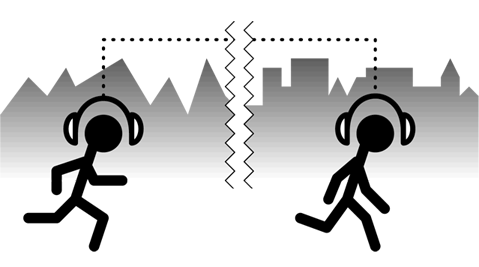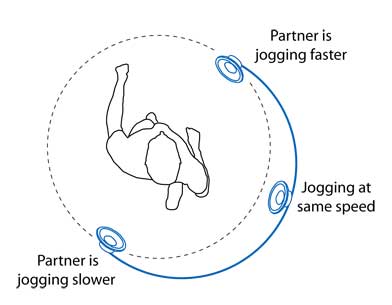Jogging over a Distance
Jogging over a Distance supports pace awareness through spatialized audio: if you are faster, your friend's voice appears from behind through the headphones, indicating you are 'ahead', if you are slower, you have to increase your effort to catch up!
We have found through the use of an online survey and Internet forums that joggers often run with others. The main reasons for 'social jogging' were socializing, motivation to run faster, to have more fun, and to be encouraged to run in the first place. However, due to our modern nomadic lifestyle, jogging friends often move apart, and hence we designed "Jogging over a Distance" to allow social joggers, who now live in separate places, to utilize the benefits of running together although being apart.
Jogging over a Distance experienced several iterations, and we now present the latest, Jogging over a Distance 4.0. The video documents a previous version, and a complete history can be found in the publications below.
Jogging over a Distance

With Jogging over a Distance, each jogging partner puts on a pair of headphones and wears the remaining equipment in a small pouch around the waist. While each partner jogs, heart rate data is collected and used to position the audio of the conversation in a 2D sound plane, oriented horizontally around the jogger’s head. As one jogger speaks, their partner hears the localized audio and is able to detect whether the audio is coming from the front, the side, or from behind, and thus the other person is putting more effort in, the same, or less. Similar to a collocated setting, the audio cues runners when to speed up or slow down in order to “stay” with their partner. The joggers can discuss running routes, motivate each other to keep pace, or simply listen to the environment noises of the other location.

Marathon Runner with Jogging Novice
Using augmented heart rate data allows joggers with differing athletic abilities to run together: a marathon runner can jog with a complete novice! Thus, the system allows joggers to do something that is not possible when running side by side - challenge their individual effort level while running with friends who run at different intensity.
This approach uses technology not just as a tool to overcome the limitations of distance, but rather as an opportunity to create experiences not possible without the distance: We call it "beyond jogging together".
Technical Implementation

Jogging over a Distance consists of two identical systems, each with a miniature computer, a heart rate monitor (the graphic shows the initial GPS version), a mobile phone connected via Bluetooth for voice and data, and a headset. Heart rate data is collected wireless and sent to the mini computer. The computer then transmits this data via the 3G connection of the mobile phone to a server, which calculates the relative effort people invest into the run. As a result of this, an algorithm calculates a sound position value for each jogger. As each jogger talks, their voice is picked up by a microphone and the audio is transmitted via a mobile phone. (We initially used VoIP technology, but found the lag and reliability insufficient for our purposes.) Before routing the incoming audio from the remote jogger’s mobile phone to the headphones, the mini computer applies a spatialization algorithm to the sound source. The mini computer uses the sound position value received from the server to transform the audio data into spatial 2D audio by placing the sound source onto an imaginary plane around the joggers head. The result is that the jogger hears their partner’s voice coming from a certain direction.
Background
We were initially interested in the experience joggers would have if they would communicate with a remote partner through an audio channel only, and therefore asked 18 volunteers to go running at the same time, but in opposite directions, equipped with a mobile phone and a Bluetooth headset. We were intrigued by how much of a sense of presence the audio conveyed to the participants: they not only mentioned hearing the other person’s voice, but also the wind, the noise of the footsteps depending on the ground surface, and the breathing of the remote jogger, which they amounted to a social and enjoyable experience. Two of the participants took up our idea and decided to jog regularly together through a mobile phone connection beyond the duration of the study, confirming that remote jogging with an audio interface can result in a desirable experience. Acknowledgements
This work was based on a survey on social jogging, which was initially supported by CeNTIE (Centre for Networking Technologies for the Information Economy), which is supported by the Australian Government through the Advanced Networks Program (ANP) of the Department of Communications, Information Technology and the Arts and the CSIRO ICT Centre. A newer version of the system was supported by Distance Lab, UK. We would like to thank Stefan Agamanolis, Matt Karau, Andrea Taylor, Elena Corchero, Chris Wolf and all our participants. Thanks also to Lana Dauberman for shooting the video.
Publications
![]() Mueller, F., Vetere, F., Gibbs, M. R., Agamanolis, S., & Sheridan, J. (2010) Jogging over a Distance: The Influence of Design in Parallel Exertion Games. ACM Siggraph 2010.
Mueller, F., Vetere, F., Gibbs, M. R., Agamanolis, S., & Sheridan, J. (2010) Jogging over a Distance: The Influence of Design in Parallel Exertion Games. ACM Siggraph 2010.
![]() Mueller, F. (2009) Digital Sport: Merging Gaming with Sports to Enhance Physical Activities Such as Jogging. In Digital Sport for Performance Enhancement and Competitive Evolution: Intelligent Gaming Technologies. http://www.igi-global.com/reference/details.asp?ID=33413&v=tableOfContents
Mueller, F. (2009) Digital Sport: Merging Gaming with Sports to Enhance Physical Activities Such as Jogging. In Digital Sport for Performance Enhancement and Competitive Evolution: Intelligent Gaming Technologies. http://www.igi-global.com/reference/details.asp?ID=33413&v=tableOfContents
![]() Mueller, F., (2008) Long-distance sports, in Computers in Sports book, Dabnichki, P., Baca, A. (eds.), WIT Press, UK.
Mueller, F., (2008) Long-distance sports, in Computers in Sports book, Dabnichki, P., Baca, A. (eds.), WIT Press, UK.
![]() O'Brien, S. & Mueller, F. (2007) Jogging the distance. Proceedings of the SIGCHI conference on Human Factors in computing systems. San Jose, California, USA, ACM. Note CHI ’07 (acceptance rate 25%, tier 1+)
O'Brien, S. & Mueller, F. (2007) Jogging the distance. Proceedings of the SIGCHI conference on Human Factors in computing systems. San Jose, California, USA, ACM. Note CHI ’07 (acceptance rate 25%, tier 1+)
![]() Mueller, F. O’Brien, S., Thorogood, A. (2007) Jogging over a Distance – Citywide. Demo PerGames’07-Pervasive Gaming Applications (acceptance rate 50%)
Mueller, F. O’Brien, S., Thorogood, A. (2007) Jogging over a Distance – Citywide. Demo PerGames’07-Pervasive Gaming Applications (acceptance rate 50%)
![]() Mueller, F., O’Brien, S., Thorogood, A. (2007) Jogging over a Distance. Interactivity CHI ’07 (tier 1+)
Mueller, F., O’Brien, S., Thorogood, A. (2007) Jogging over a Distance. Interactivity CHI ’07 (tier 1+)
![]() Mueller, F., O'Brien, S. & Thorogood, A. (2007) Jogging over a Distance: Supporting a "Jogging Together" Experience Although Being Apart. CHI '07: Conference on Human Factors in Computing Systems. San Jose, CA, USA. ACM, 2579 - 2584.
Mueller, F., O'Brien, S. & Thorogood, A. (2007) Jogging over a Distance: Supporting a "Jogging Together" Experience Although Being Apart. CHI '07: Conference on Human Factors in Computing Systems. San Jose, CA, USA. ACM, 2579 - 2584.
![]() O’Brien, S., Cole, L., Mueller, F. (2006) Holding Hands Over a Distance: Technology Probes in an Intimate, Mobile Context, OzCHI ‘06
O’Brien, S., Cole, L., Mueller, F. (2006) Holding Hands Over a Distance: Technology Probes in an Intimate, Mobile Context, OzCHI ‘06
Press
TechNewsDaily: Interactive game keeps jogging buddies in touch
Discovery News: http://dsc.discovery.com/news/2007/05/10/joggingbuddy_tec.html?category=technology&guid=20070510100000
ABC: http://abc.net.au/science/news/stories/2007/1920528.htm?tech
The University of Melbourne Voice: http://uninews.unimelb.edu.au/articleid_4246.html
Bright magazine (Netherlands): http://www.bright.nl/solo-sociaal-hardlopen-zet-aan-tot-grotere-prestaties
Information Aesthetics: http://infosthetics.com/archives/2007/05/jogging_over_a_distance.html
Textually.org: http://www.textually.org/textually/archives/2007/05/015897.htm
ACM Tech News: http://technews.acm.org/archives.cfm?fo=2007-05-may/may-14-2007.html#311543
A2mediagroup: http://www.a2mediagroup.com/pdf.php?a=15087
What's new: http://www.whatsnew.tv/Article.aspx?id=143
Computerpoweruser: http://www.computerpoweruser.com/editorial/article.asp?article=articles%2Farchive%2Fc0709%2F64c09%2F64c09.asp
IGI Global: http://www.igi-global.com/newsletter/may09/MayShape.html
Radio: (broadcasted in Australia as part of whatsnew.tv) jogging_over_a_distance.mp3
Video
The video from above is also available to download (right-click, save as) in MPEG 2 format (DVD quality, 39 MB) and iPod format (MP4, 8 MB).



 Jogging over a Distance
Jogging over a Distance


